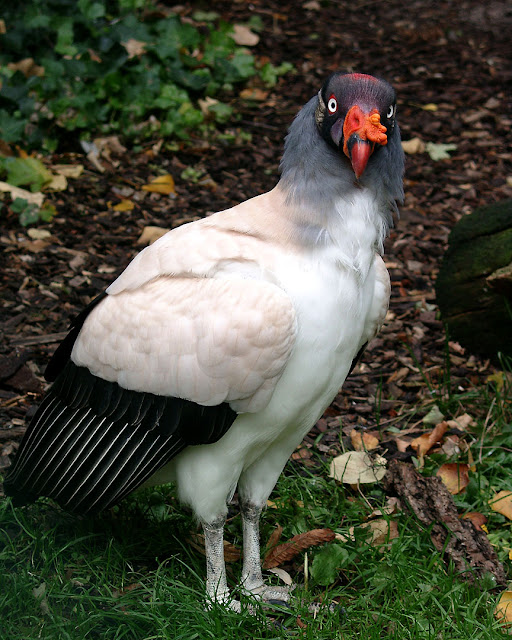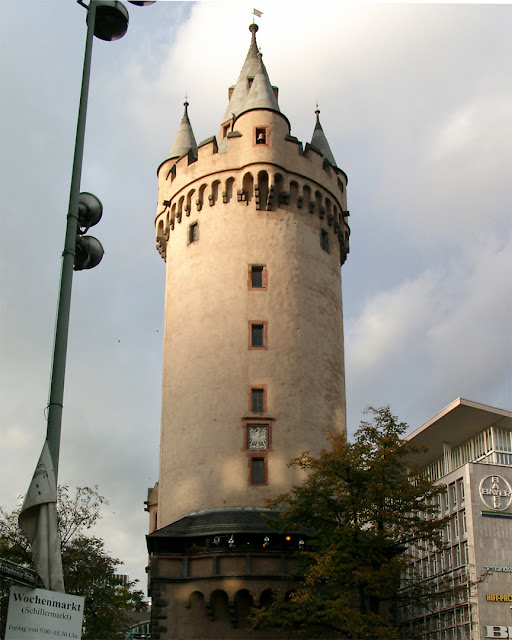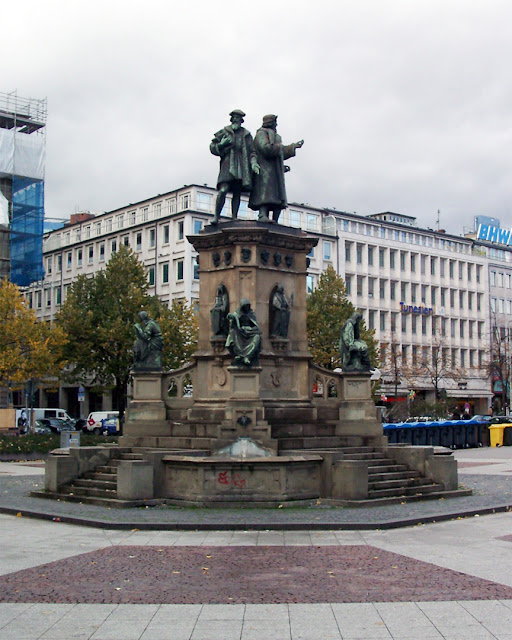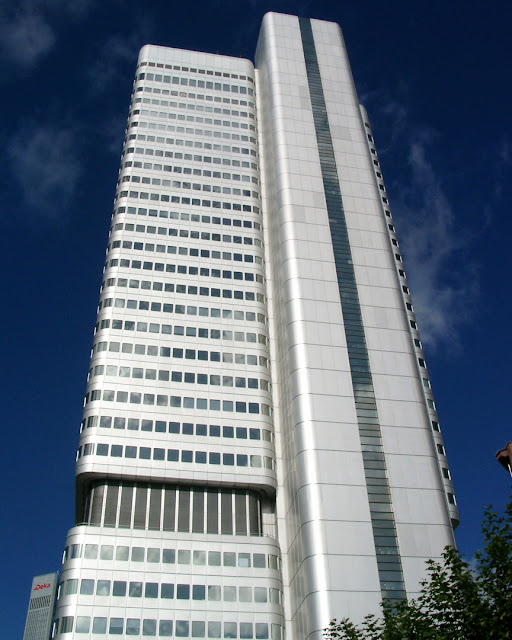Saturday, January 31, 2004
Friday, January 30, 2004
King Vulture
King vulture (Sarcoramphus papa)
Zoologischer Garten Frankfurt (Frankfurt Zoological Garden)
Bernhard-Grzimek-Allee
Frankfurt, October 2002
“Large and predominantly white, the king vulture has gray to black ruff, flight, and tail feathers. The head and neck are bald, with the skin color varying, including yellow, orange, blue, purple, and red. The king vulture has a very noticeable yellow fleshy caruncle on its beak. This vulture is a scavenger and it often makes the initial cut into a fresh carcass. It also displaces smaller New World vulture species from a carcass. King vultures have been known to live for up to 30 years in captivity.” (King vulture, Wikipedia)
Thursday, January 29, 2004
Wednesday, January 28, 2004
Black rhinoceros
Black rhinoceros
Zoologischer Garten Frankfurt (Frankfurt Zoological Garden)
Bernhard-Grzimek-Allee
Frankfurt, October 2002
“The black rhinoceros or hook-lipped rhinoceros (Diceros bicornis) is a species of rhinoceros, native to eastern and southern Africa including Angola, Botswana, Kenya, Malawi, Mozambique, Namibia, South Africa, Eswatini, Tanzania, Zambia, and Zimbabwe. Although the rhinoceros is referred to as black, its colours vary from brown to grey. The other African rhinoceros is the white rhinoceros (Ceratotherium simum). The word ‘white’ in the name ‘white rhinoceros’ is often said to be a misinterpretation of the Afrikaans word wyd (Dutch wijd) meaning wide, referring to its square upper lip, as opposed to the pointed or hooked lip of the black rhinoceros. These species are now sometimes referred to as the square-lipped (for white) or hook-lipped (for black) rhinoceros. The species overall is classified as critically endangered (even though the south-western black rhinoceros is classified as near threatened). Three subspecies have been declared extinct, including the western black rhinoceros, which was declared extinct by the International Union for Conservation of Nature (IUCN) in 2011.” (Black rhinoceros, Wikipedia)
Tuesday, January 27, 2004
Grasshoppers
Grasshoppers
Zoologischer Garten Frankfurt (Frankfurt Zoological Garden)
Bernhard-Grzimek-Allee
Frankfurt, October 2002
Monday, January 26, 2004
Red howler monkey
Red howler monkey
Zoologischer Garten Frankfurt (Frankfurt Zoological Garden)
Bernhard-Grzimek-Allee
Frankfurt, October 2002
Sunday, January 25, 2004
Zoogesellschaftshaus
Zoogesellschaftshaus
Zoologische Gesellschaft Frankfurt (ZGF)
Frankfurt Zoological Society (FZS)
Alfred-Brehm-Platz
Frankfurt, October 2002
“Frankfurt Zoological Society (FZS) is an international conservation organization founded in 1858 with headquarters in Frankfurt am Main, Germany. FZS focuses on maintaining biodiversity and conserving wildlife and ecosystems in protected areas and outstanding wild places. FZS leads and supports about 30 projects in 18 countries. Bernhard Grzimek, renowned German zoo director, zoologist, book author, editor, and animal conservationist in postwar West-Germany, served as president of the Frankfurt Zoological Society for over forty years.” (Frankfurt Zoological Society, Wikipedia)
Saturday, January 24, 2004
Friday, January 23, 2004
Thursday, January 22, 2004
Wednesday, January 21, 2004
Tuesday, January 20, 2004
Liebfrauenkirche
Liebfrauenkirche (Church of Our Lady)
Liebfrauenstraße
Frankfurt, October 2002
“Liebfrauenkirche (Our Lady, literally Dear Lady) is a Gothic-style Catholic parish church, located in the centre of Frankfurt, Germany. It was built in several phases from the 14th to the 16th century and serves today as a monastery church. Close to the shopping district, it serves as a place of rest even to visitors who are not religious. With an organ completed in 2008, it is a major venue for church music events. The first sacred building on the site began as a family chapel, which was made in 1325 a collegiate church by the archbishop of Mainz, Matthias von Buchegg, dedicated to Mary (Unsere liebe Frau). It was the third collegiate in the town, after that of St. Bartholomew attached to the Frankfurt Cathedral, and St. Leonhard, founded in 1317. In 1344 the chapel was expanded to a Gothic hall church of three naves. A document about its consecration mentions two altars. From 1415, the south facade was transformed, including a tympanum showing the Adoration of the Magi made by the workshop of Madern Gerthener. In 1453 the town council permitted to change an adjacent tower of the fortication to a bell tower. From 1506 to 1509 the church was once more expanded, by Jörg Östereicher. The church remained Catholic, part of the Diocese of Mainz, even when the Reformation was introduced in Frankfurt in 1533. The church was partly changed to Baroque style from 1763 to 1771. The helmet of the tower was replaced by the one still seen today. The interior was changed almost completely, installing five new altars and a chancel from Mainz workshops. An organ by the Frankfurt organ builder Ernst Weegmann was built at around the same time, installed in 1763. With the secularisation in 1803, Frankfurt became the owner of the church. Friedrich Rumpf built in 1824 a new entrance protecting the tympanum. A Walcker organ was installed in 1864. From 1923, Capuchins became the spiritual leaders, who built a convent north of the church. The church was completely destroyed by bombing in World War II in 1944. Only fragments of the high altar and statue of Mary could be saved. The church was restored in the 1950s, but in a simplified form, replacing the Gothic vaults by wooden ceilings.” (Liebfrauen, Wikipedia)
Monday, January 19, 2004
Sunday, January 18, 2004
Struwwelpeter-Brunnen
Struwwelpeter-Brunnen, fountain by Franziska Lenz-Gerharz
Schillerstraße, Hauptwache
Frankfurt, October 2002
Saturday, January 17, 2004
Debit and Credit
Soll und Haben (Debit and Credit)
Deutsche Bank Zwillingstürme (Deutsche Bank Twin Towers)
Taunusanlage
Frankfurt, October 2002
Friday, January 16, 2004
Thursday, January 15, 2004
Wednesday, January 14, 2004
Tuesday, January 13, 2004
Monday, January 12, 2004
Sunday, January 11, 2004
Saturday, January 10, 2004
Wine-Dark Sea
Eiserner Steg (Iron Footbridge)
Mainkai
Frankfurt, October 2002
“πλέων ἐπὶ οἴνοπα πόντον ἐπ’ ἀλλοθρόους ἀνθρώπους”
(While sailing over the wine-dark sea to men of strange speech)
Homer, Odyssey, I, v. 183
“Robert Fitzgerald, the American translator of Homer, noted in an interview that the literal translation of the phrase is ‘wine-faced sea.’ Still, he uses ‘wine-dark sea.’ As a romantic expression, he said, it ‘can't be improved on.’ Years ago, Mr. Fitzgerald recalled, he had an intimation of what the minstrels and Homer might have had in mind. He was on a ship coming out of the Corinth Canal into the Saronic Gulf of the Aegean Sea. ‘The contrast of the bare arid baked land against the sea,’ Mr. Fitzgerald said, ‘gave the sea such a richness of hue that I felt as though we were sailing through a bowl of dye. The depth of hue of the water was like the depth of hue of a good red wine. So I associate the expression with the richness of hue rather than a specific color. I've been content with that as my personal interpretation.’” (Homer's Sea: Wine Dark?, The New York Times)
Friday, January 9, 2004
Thursday, January 8, 2004
Pati potius fato
“Pati potius fato” (To suffer is stronger than fate)
Coat of arms of the Gold-Kraemer-Stiftung
Zeil
Frankfurt, October 2002
Wednesday, January 7, 2004
Tuesday, January 6, 2004
Main Tower
Main Tower, 1999
Neue Mainzer Straße
Frankfurt, October 2002
“Main Tower is a 56-storey, 200 m (656 ft) skyscraper in the Innenstadt district of Frankfurt, Germany. It is named after the nearby Main river. The building is 240 m (787 ft) when its antenna spire is included. The tower has five underground floors and two public viewing platforms. It is the only skyscraper in Frankfurt with a public viewing observatory. It is the 4th tallest building in Frankfurt and the 4th tallest in Germany, tied with Tower 185. The foyer of the building has two art pieces accessible to the public: the video installation by Bill Viola ‘The World of Appearances’ and the wall mosaic by Stephan Huber ‘Frankfurter Treppe / XX. Jahrhundert’ (Frankfurt's Steps/20th century). The tower's design features what appears to be two connected towers. The smaller of the two is of a cuboid shape and a design common to 1970s architecture. The second and taller of the two towers is a circular tower with an entire blue glass exterior which features the transmission tower on top.” (Main Tower, Wikipedia)
Monday, January 5, 2004
Sunday, January 4, 2004
Gutenberg Memorial
Johannes-Gutenberg-Denkmal by Eduard Schmidt von der Launitz, 1840
Roßmarkt
Frankfurt, October 2002
“This memorial was inaugurated on the occasion of the 400th anniversary of the invention of printing by movable type and commemorates its creator, Johannes Gutenberg. The Gothic-style sandstone structure is made up of three massive statues, representing Gutenberg and his printers and patrons, Hans Fust and Peter Schöffer. The main causes for the invention of the time-honoured art of book-printing - theology, poetry, natural sciences and industry - are represented as allegorical figures, sitting at the corners of the memorial's base, which in turn is adorned by a frieze featuring the busts of famous printers, publishers and booksellers. The crests depicted stand for Mainz, Strasbourg, Frankfurt and Venice, the cities where printing first left its mark in modern times.” (Gutenberg Memorial, Frankfurt Tourismus)
Saturday, January 3, 2004
Commerzbank Tower
Commerzbank Tower by Norman Foster, 1997
Kaiserplatz
Frankfurt, October 2002
“Commerzbank Tower is a 56-story, 259 m (850 ft) skyscraper owned by Samsung of Korea since September 2016 in the banking district of Frankfurt, Germany. An antenna spire with a signal light on top gives the tower a total height of 300.1 m (985 ft). It is the tallest building in Frankfurt and the tallest building in Germany. It had been the tallest building in Europe from its completion in 1997 until 2003 when it was surpassed by the Triumph-Palace in Moscow. Since the departure of the United Kingdom from the European Union, the tower has reclaimed its position as the tallest building in the European Union. The Commerzbank Tower is only two metres taller than the Messeturm, which is also located in Frankfurt and was the tallest building in Europe before the construction of the Commerzbank Tower. Commerzbank Tower was designed by Foster & Partners, with Arup and Krebs & Kiefer (structural engineering), J. Roger Preston with P&A Petterson Ahrens (mechanical engineering), Schad & Hölzel (electrical engineering). Construction of the building began in 1994 and took three years to complete. The building provides 121,000 m2 (1,300,000 sq ft) of office space for the Commerzbank headquarters, including winter gardens and natural lighting and air circulation. The building is lighted at night with a yellow lighting scheme that was designed by Thomas Ende who was allowed to display this sequence as a result of a competition. In its immediate neighbourhood are other skyscrapers including the Eurotower (former home of the European Central Bank), the Main Tower, the Silberturm, the Japan Center and the Gallileo. The area forms Frankfurt's central business district, commonly known as Bankenviertel.” (Commerzbank Tower, Wikipedia)
Friday, January 2, 2004
Thursday, January 1, 2004
Silberturm
Silberturm (Silver Tower)
Jürgen-Ponto-Platz
Frankfurt, October 2002
“Silberturm (Silver Tower), formerly known as Dresdner-Bank-Hochhaus and Jürgen-Ponto-Hochhaus, is a 32-storey, 166.3 m (546 ft) futurist skyscraper in the Bahnhofsviertel district of Frankfurt, Germany. It was the tallest building in Germany from 1978 until 1990. Until 2009 it was part of the headquarters of Dresdner Bank, one of Germany's largest banks until its merger with Commerzbank in 2009. As of 2012 the main tenant is Deutsche Bahn. Built by Bilfinger Berger, the Silberturm is located at Jürgen-Ponto-Platz, which opens onto Kaiserstrasse. The square is named after Jürgen Ponto, the former CEO of Dresdner Bank who was murdered in 1977 by members of the Red Army Faction (RAF). The Silberturm, along with the seven-story building Gallusanlage 8, formed the Dresdner Bank Headquarters from 1978 to 2008. In 2003, a new tower (Gallileo) was built. After the takeover of Dresdner Bank by Commerzbank in early 2009, the new owner planned to sell the Silberturm because the office space was no longer needed. But since a sale of the building, which is worth approximately 200 million euros, was no longer deemed possible in the wake of the financial crisis, the complete high-rise and also the Gallusanlage 8 building were leased on long term to Deutsche Bahn in the summer of 2009. The Gallileo highrise will continue to be used by Commerzbank.” (Silberturm, Wikipedia)
Subscribe to:
Posts (Atom)































